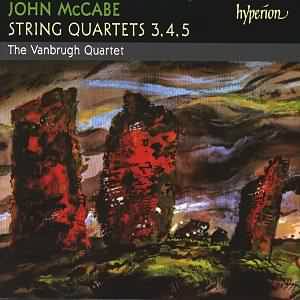
The three string quartets on this disc convey the impeccable craftsmanship
of their composer at every turn. Far from being restricted by the medium
of the string quartet, John McCabe seems to have been inspired to write some
of his most searching and colourful scores. Typically, none of the three
quartet adhere to the conventional four movement format of the traditional
string quartet yet there is no feeling of experimentation for its own sake,
the structures seemingly determined by the musical argument rather than the
other way around.
The Third String Quartet (1979) was commissioned by the Fishguard Festival
and premiered by the Gabrielli Quartet. The work is cast in five satisfying
movements forming an arch in three sections. There is both lyrical humanity
and powerful logic to be enjoyed in this work and the Vanbrugh Quartet proves
to be an ideal exponent of the piece, coping particularly brilliantly with
the stark juxtaposition of fast and slow sections within the piece.
The Fourth Quartet (1982) was written in joint celebration of the Delme Quartet's
20th anniversary and Joseph Haydn's 250th anniversary. John McCabe has long
been associated with Haydn (his peerless interpretations of the Piano Sonatas
are still available on CD on the Decca label). The beautiful slow movement
of his Third Symphony, inspired by the slow movement of String Quartet of
Haydn's op76 no 6, bears witness to John McCabe's ability to translate his
love of Haydn into a stunning act of homage. In the Fourth String Quartet
something of Haydn's inexhaustible invention informs the inner logic and
outer joy of this work. In one compact 20-minute movement, the haunting opening
theme spawns nine ever-inventive and individual variations. These variations
develop the theme in unexpected ways and pay tribute to the composer's
craftsmanship.
The Fifth Quartet (1989), like the Third, was commissioned by the Fishguard
Festival and premiered by the Gabrielli Quartet. John McCabe found inspiration
for the work from a series of copper etchings by Graham Sutherland entitled
"The Bees" (what a pity these etchings could not have been reproduced either
in the sleeve notes or, preferably, on the cover). The fourteen movements
divide into what might be described as a traditional three-movement structure.
Symphonic in its organic growth and immediately attractive in its lyricism,
this is the most approachable of the quartets on this disc and is probably
the best place to start for anyone unfamiliar with the works of John McCabe.
Its melodies and their working out are easily assimilated (the programmatic
element may help here) and the names of Bartok and Shostakovitch spring to
mind when searching for comparable talent writing in this medium in the 20th
Century.
The Vanbrugh Quartet (based in Cork) is an ideal interpreter of this music,
digging deep into these quartets and mining from it much that is precious.
Meticulously prepared and strongly projected, these performances will prove
hard to equal, let alone surpass. The programme notes by Guy Rickards are
as informative and detailed as anyone could wish, complete with musical examples.
There is the luxury of 40 different cue points on the CD to assist with more
detailed analysis of the music (well worth attempting). The Hyperion recording
is beyond reproach: splendidly life-like and detailed. Strongly recommended.
Reviewer
Paul Conway

